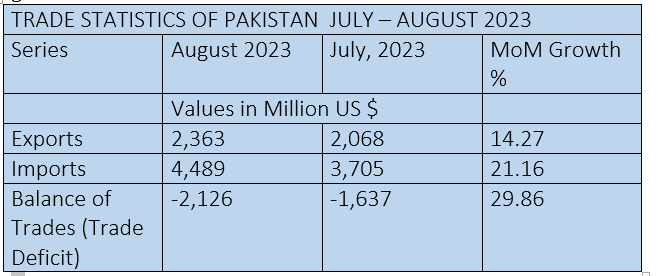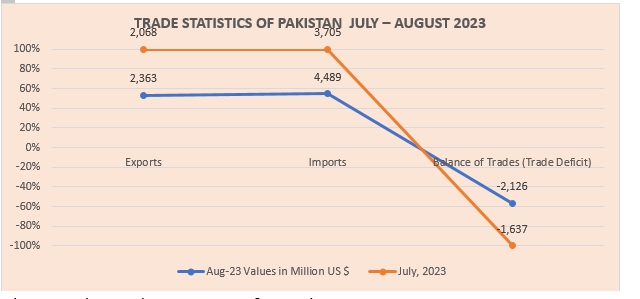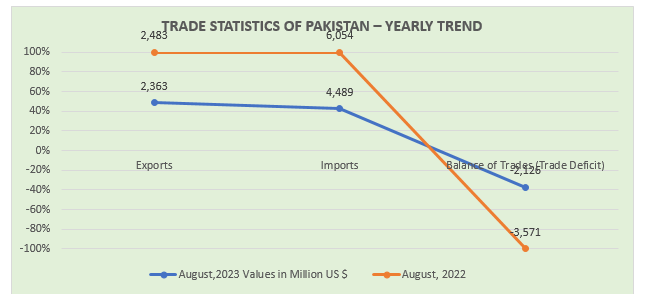INP-WealthPk
Qudsia Bano
Pakistan has been facing the pressing economic challenge of persistent trade imbalance that demands immediate attention. The country’s trade deficit has been a cause for concern for policymakers and economists alike, with its repercussions extending far beyond the balance of trade. A trade imbalance occurs when a country’s imports surpass its exports, resulting in a deficit. In Pakistan’s case, this trade deficit has been growing steadily over the years, with imports consistently outpacing exports. However, in a significant turn of events, Pakistan’s trade deficit witnessed a remarkable decline of over 40% during the first two months of the fiscal year 2023-24 compared to the previous fiscal year, according to the data released by the Pakistan Bureau of Statistics (PBS).
The figures indicate that Pakistan’s exports increased from $2.068 billion in July to $2.363 billion in August, marking a significant month-on-month growth of 14.27%. On the flip side, the data shows a substantial surge in imports during the same period. Imports rose from $3.705 billion in July to $4.489 billion in August, representing a noteworthy month-on-month growth of 21.16%. While increased imports can indicate economic activity and demand, a significant surge can also contribute to a widening trade deficit, as seen in these data. The trade deficit increased from -$1.637 billion in July to $2.126 billion in August, marking a considerable month-on-month growth of 29.86%.


The yearly trade statistics for Pakistan, comparing August 2023 with August 2022, provide valuable insights into the country’s trade performance over this period. In terms of exports, the data shows that Pakistan’s exports in August 2023 were valued at $2.363 billion, which is a decrease from $2.483 billion in August 2022, marking a year-on-year decline of 4.83%. Conversely, there was a significant contraction in imports during the same period. In August 2023, Pakistan’s imports were valued at $4.489 billion, considerably lower than the $6.054 billion recorded in August 2022. This represents a substantial year-on-year decrease of 25.85%. In August 2023, the trade deficit stood at -$2.126 billion, compared to -$3.571 billion in August 2022, marking a substantial year-on-year reduction of 40.46%.


Dr Khurram Mughal, a senior economist, told WealthPK that Pakistan’s recent progress in reducing its trade deficit was a positive step, but the road to achieving a trade surplus and boosting exports required strategic reforms and ongoing efforts. “A crucial reform is diversifying Pakistan’s export base. Currently, the nation heavily relies on sectors like textiles and agriculture, which are susceptible to global market fluctuations. Encouraging the development of new export-oriented industries and innovative products can mitigate this risk,” he pointed out. He said that emphasising value addition was another key strategy.
“By processing raw materials locally before export, the country can increase the value and profit margin of its exports.” He stressed that modernising infrastructure, including ports, transport networks, and communication systems, was essential to improving the competitiveness of Pakistani products in the global market. “These investments can reduce transaction costs and enhance export efficiency,” Khurram said, adding that small and medium-sized enterprises were vital for exports. “Facilitating access to affordable finance for SMEs can stimulate their growth and export capabilities. Simplifying regulatory requirements and ensuring transparency are also crucial,” the economist stressed.
Credit: INP-WealthPk













